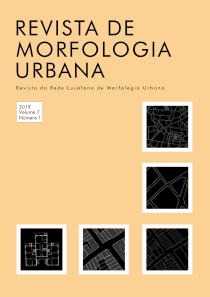Abstract
This article presents a study of the relationship between the architectural type, land use and dynamics of the centers of the cities of Florianópolis and Balneário Camboriú, from its main central commercial streets, the goal is to recognize and describe what elements ensure greater vitality. First, we present a brief literature review, including the recents empirical studies that highlight the reflex of the architecture type and the urban form in the use and dynamic of the streets. In a second step, we analyzed the spatial transformation of the two centers through a historical approach. The last approach is an empirical analysis of the two streets through three previously selected sections, through a systematic observation. The results suggest that the density of economies, configuration and dynamics of the roads, land uses and interaction between public and private space have a strong influence on the vitality of these centers. Felipe Schmidt Street in Florianópolis, because it has three distinct sections morphologically, has a very variable vitality. At Brasil Avenue, in Balneário Camboriú, commercial uses on the ground floor in conjunction with housing density guarantee its constant use. Despite having different temporalities, the movement in the streets and the architectural types adjust and influence each other over time, with direct consequences for the vitality of urban areas.
References
Cano D. S., Sampaio, I. T. A. (2007) O Método de Observação na Psicologia: Considerações sobre a Produção Científica. Interação em Psicologia. 11 (2), 199–210. Disponível em: http://dx.doi.org/10.5380/psi.v11i2.6849
Danielski, M. (2009) Padrão Arquitetônico e Representação Social na Paisagem da Beira Mar de Balneário Camboriú. Dissertação de Mestrado, Universidade Federal de Santa Catarina, Florianópolis. Disponível em: http://repositorio.ufsc.br/xmlui/handle/123456789/92226
Danna, M., Matos, M. (2006) Aprendendo a observar. São Paulo, Edicon.
Gehl, J.; Kaefer, L. J.; Reigstad, S. (2006) Close encounters with buildings. Urban Design International. 11 (1), 29–47. Disponível em: https://doi.org/10.1057/palgrave.udi.9000162
Gehl, J. (2011) Life between buildings: using public space. Copenhagen, The Danish Architectural Press.
Gehl, J. (2013) Cidade para Pessoas. São Paulo, Perspectiva.
IBGE, Censo Demográfico (2010). Dispoível em: http://www.cidades.ibge.gov.br/. [Acesso em Agosto de 2017].
Jacobs, J. (2011) Morte e Vida de grandes cidades. São Paulo, Martins Fontes.
Jones, C., Al-Shaheen, Q., Dunse, N. (2016) Anatomy of a successful high street shopping centre. Journal Urban Design. 21, 495-511. Disponível em: http://doi.org/10.1080/ 13574809.2016.1192947
Mehta, V. (2007) Lively Streets. Journal of Planning Education And Research. 27 (2), 165-187. Disponível em: https://doi.org/10.1177/ 0739456X07307947
Mehta, V., Bosson, J. K. (2018) Revisiting Lively Streets: Social Interactions in Public Space. Journal of Planning Education And Research. 00 (0), 1-13. Disponível em: https://doi.org/10.1177/0739456X18781453
Montgomery, J. (1998) Making a city: Urbanity, vitality and urban design. Journal of Urban Design. 3 (1), 93-116. Disponível em: https://doi.org/10.1080/13574809808724418
Netto, M. V. (2012) O que é afinal urbanidade? Notas sobre um diálogo tortuoso. Em: Urbanidades. 13-33. Rio de Janeiro, Letra e Imagem.
Rodríguez, D. A., Khattak, A. J., Evenson, K. R. (2006) Can New Urbanism Encourage Physical Activity?: Comparing a New Urbanist Neighborhood with Conventional Suburbs. Journal Of The American Planning Association. 72 (1), 43-54. Disponível em: http://dx.doi.org/10.1080/01944360608976723
Veiga, E. V. (1993) Florianópolis: memória urbana. Florianópolis, Fundação Franklin Cascaes.
Whyte, H. W. (1980) The social life of small urban spaces. New York, Project for Public Spaces.
Zook, J. B., Lu, Y., Glanz, K., Zimring, C. (2011). Design and Pedestrianism in a Smart Growth Development. Environment and Behavior. 44 (2), 216-234. Disponível em: https://doi.org/10.1177/ 0013916511402060.
Os direitos autorais permanecem com os autores, que autorizam a Revista de Morfologia Urbana a publicar o artigo sob uma licença Creative Commons Atribuição (CC-By).


